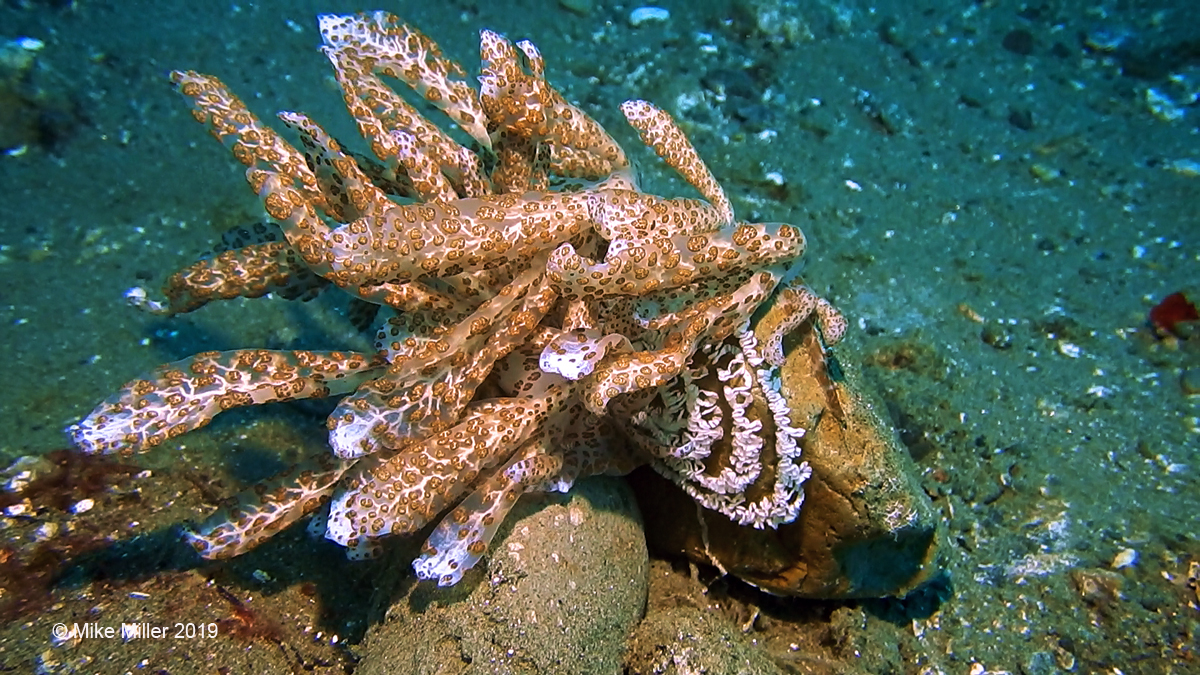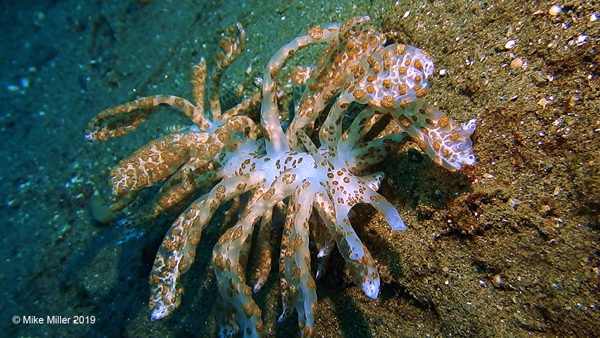 |
Phyllodesmium longicirrcum
Image courtesy of WebmasterAmbon, Indonesia
Freeze Frame from Video
 | Phyllodesmium longicirrcum (Bergh, 1905) Truly the original "Solar Sea Slug", this specie gets most of its nutrition from the microscopic zooxanthellae it gets from eating leather coral, Sacrophyton sp. and sequestering them in a complex system plumbing throughout the body. This species lives in very shallow water where it takes advantage of the opt6imal solar radiation. The zooxanthellae, use the sunlight to provide energy to carry out Photosynthesis (aka - the Solar Sea Slug). The sun energy converts water and carbon dioxide found in seawater to oxygen (O2) and a six carbon sugar (glucose). Not only do the zooxanthellae essentially breathe for the slug, they produce nutritious sugar to meet the slug's dietary needs. Phyllodesmium longicirrum is probably the largest aeolid in the Indo-Pacific. It may reach lengths exceeding 120 mm. Its golden brown patches in the cerata and on the body house the zooxanthellae and are connected by a complex plumbing system (white tubes) that transports the oxygen and glucose to the gut. What is special about Mike's photo here is the presence of the egg ribbon, which I have never seen before. Typically aeolid in morphology, it is an undulating string of egg capsules laid in a coil. The species, originally described by Rudolf Bergh while on the Siboga Expedition in Indonesia, has now been recorded from throughout the Western Pacific Ocean. |
Sammamish, WA 98074
Aug. 2019
Send Dave email at davidwbehrens@gmail.com

Attention all you Sluggers, and you know who you are! The NSSI 2nd edition is now available in ebook PDF and book form . The hard back version will become available Nov. 1st. Both will cost $65 (individually). You will need to jump through a few hoops to get the electronic version as pdf distribution is protected by Adobe ID!! Please read the following to enable reading your electronic purchase! This new 2nd Edition is updated and reorganized, including 185 new species. Among other features, the new edition includes additional photographs of species, an identification key, and an up-to-date classification reflecting the latest evolutionary relationships. The Indo-Pacific represents the largest expanse of tropical ocean in the world, stretching from the Indian Ocean coast of southern Africa and the Red Sea to the central Pacific of the Hawaiian Islands, Easter Island and the Marquesas. This region supports the most diverse marine fauna of any place in the world for most groups of marine organisms. The nudibranchs and sea slugs are no exception to this rule; there are about 3,000 described species of these organisms in the world and at least 40% of these have been found exclusively in the Indo-Pacific tropics. This book illustrates 2,138 Indo-Pacific nudibranchs and sea slugs, including many undescribed species.
|

|
